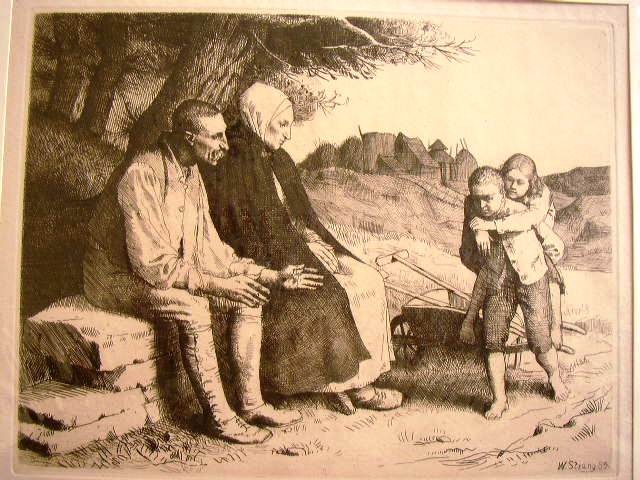
The Cottar's Family by William Strang
This is an etching by the Scottish artist William Strang. It shows a realistic scene of a family, the father and mother sitting on a stone wall and a barefoot boy carrying his sister piggyback. It dates from 1885 and is demonstrating the interest of artists in the real world, rather than the idealized world of beauty and riches. While this scene could be depicted as happy and whimsical, the parents' expressions are neutral, while the boy has a determined scowl while the girl appears tired. It suggests a hard day of work. A barrow and farm implements are behind the boy and farm buildings occupy the rear center of the scene. Trees on the frame the image with their shape and shadow. The use of light and shadow (chiaroscuro) is masterful and exemplifies the skills of artists of the etching revival started by Whistler and the French realist movement taught by Strang's teacher Legros. Scenes from the lives of common folk were the subject of many of Strang's etchings reflecting his interest in social realism. A beautiful and poignant work. The etching is mounted on a mat board (12 x 18 inches) and is in excellent condition for it's age. It is signed and dated in the plate W. Strang 85. It is well struck and inked with no fading. There is no foxing, toning, or staining. There are no tears or paper loss. An excellent example of late 19th century etching from the UK.
William Strang (1859 –1921)
William Strang was a Scottish illustrator, painter, and printmaker. He was born in Dumbarton and received his early education at the Dumbarton Academy. He moved to London at age 16 and studied drawing and etching under Alphonse Legros, one of the most noted etchers of the day, at the Slade School of Fine ultimately becoming assistant master in the etching class. He was one of the founding members of the Royal Society of Painter-Etchers, and his work was part of its first exhibition in 1881. His work was published in art magazines in the 1880s. He worked in all forms of print making and was a sought-after collaborator for illustrations. Some notable examples of his illustrations include: William Nicholson's Ballad of Aken Drum, Samuel Taylor Coleridge's Ancient Mariner, and several stories of Rudyard Kipling. He also published series of his own including Pilgrim’s Progress, Allegory of Death, and The Plowman's Wife. His work is noted for his masterful use of chiaroscuro (light and shadow) to increase the drama of his images. He was particularly noted for his uncompromising depictions of contemporary life and the effects of poverty and social injustice. The National Gallery of Scotland notes, “Strang’s closely observed depictions of the lives of the urban poor are clearly influenced by Legros as well as by a life-long respect for the traditions of the old masters Rembrandt, Dürer, Van Dyck, and Goya. In images such as Grotesque the direct manner with which he has approached the subject of poverty eschews all sentimentality or the figuratively beautiful, favoring instead honesty and psychological intensity.” This reflects the influence of Legros, a French realist who encouraged these honest depictions of life by his students. He was recognized by his peers and was a member of the Art Workers' Guild, being elected Master in 1907. In 1918, he became President of the International Society of Sculptors, Painters and Gravers and in 1921 was elected an Engraver Member of the Royal Academy. His son donated most of his works to the National Gallery of Scotland. In addition to the National Gallery of Scotland, Strang’s work is held by the National Gallery and the National Portrait Gallery, Washington, D.C., The Royal Academy, the British Museum, and the Tate, London.
Price: $225
Size: 12 x 18 inches
Plate Size: 9 x 7 inches
Condition: Excellent
Medium: Etching
Subject: Children & Infants
Shipping, handling and insurance is included for purchases within the US and Canada. We ship internationally. Please contact us for shipping cost and invoice information.

